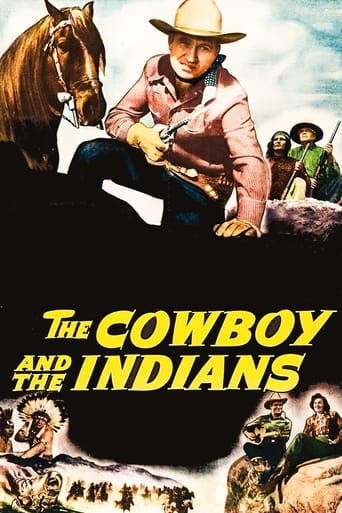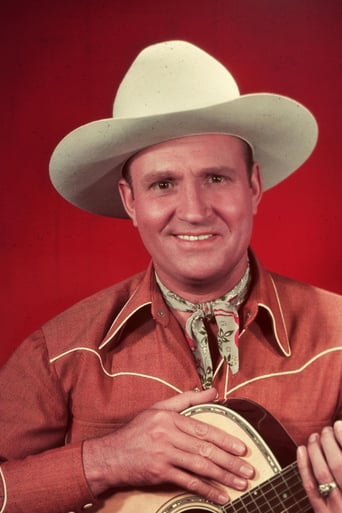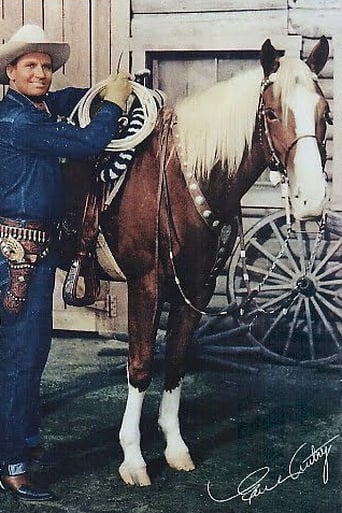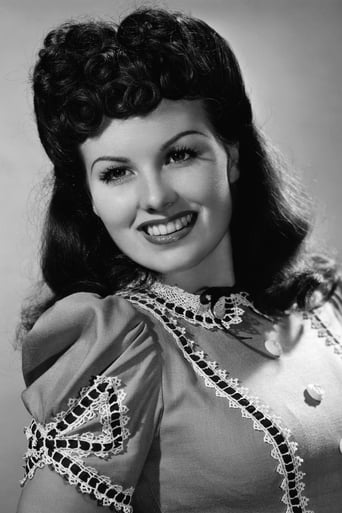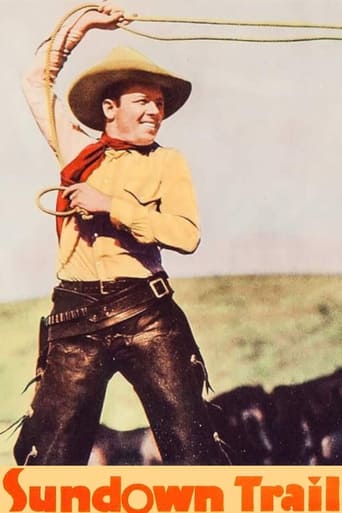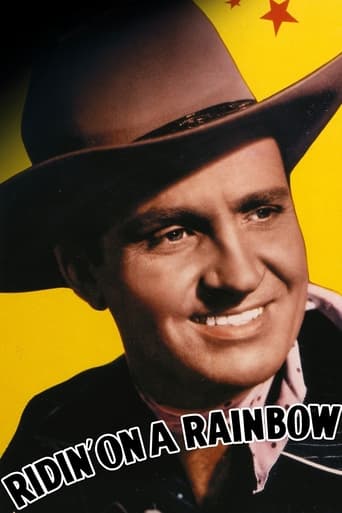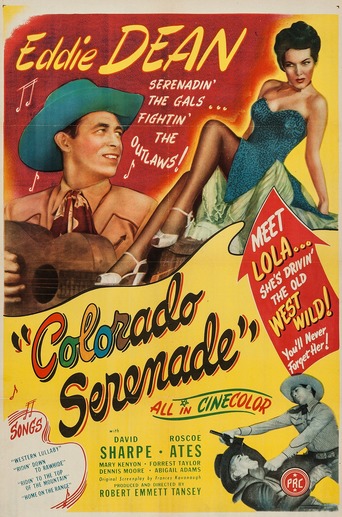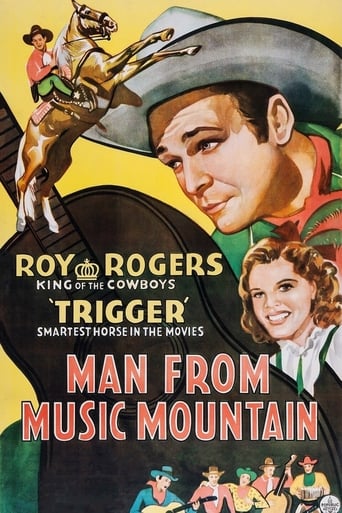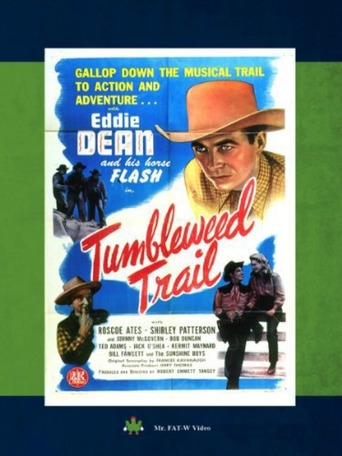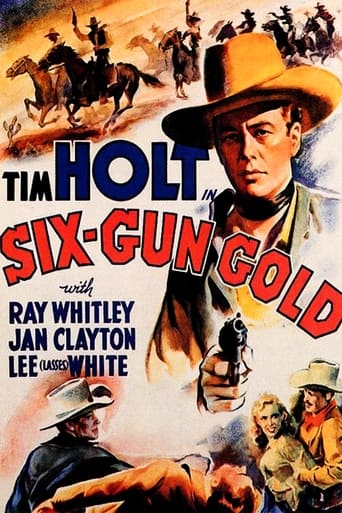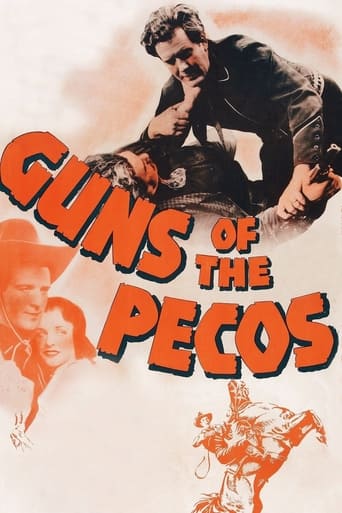The Cowboy and the Indians (1949)
Finding Indians stealing from his ranch, Gene learns they are suffering from malnutrition. Store owner Martin is cheating them and now he is after the Chief's valuable necklace. When the dying chief is found, having been attacked and robbed, Martin blames Lakhona who would become the new chief. When Gene helps Lakhona they soon find themselves fleeing from the law.
Watch Trailer
Cast
Similar titles
Reviews
Great Film overall
Good concept, poorly executed.
At first rather annoying in its heavy emphasis on reenactments, this movie ultimately proves fascinating, simply because the complicated, highly dramatic tale it tells still almost defies belief.
Although I seem to have had higher expectations than I thought, the movie is super entertaining.
Superior Autry, with lots of hard-riding, fast-shooting, and flying-fists, along with a good storyline not often seen in those days. The voice-over prologue actually explains why Indians were often hostile to the white settlers, something not often done, since their exotic looks served as useful movie canon fodder. Anyhow, the Indians are portrayed here as ordinary human beings, with a different culture but with the same needs. Then too, except for Lucy Broken Arm (Drake), real Indians are cast in leading parts, something else Hollywood did not often do.Trouble is a slippery white merchant is cheating his red man customers, such that they're having to steal food, which brings rancher Gene into the picture. Catch the great staging around the rock spires and boulders. They make a great backdrop for shootouts, and I don't think that setting was the picturesque Alabama Hills so familiar from many Hollywood oaters. Anyway, the emphasis here is on action, a humane message, and a dollop of charm (the kids) making this an unusually well-rounded Autry entry.
Although The Cowboy And The Indians is not the usual run of Gene Autry B western, it's still a good film. And if the Autry name bought in the kiddie trade, good because showed a film that has a fine and sensitive portrayal of the American Indian in modern times.The film has Gene buying a ranch, but having a lot of problems because the neighboring Indians from a reservation are grazing their own herds their and occasionally stealing some of his. But there's a real good reason for that. They're kept in near starvation because of a real sleazeball running the reservation trading post. Frank Richards is one of the scurviest villains that Gene ever had in one of his westerns. When Dr. Sheila Ryan diagnoses a case of malnutrition for an old Indian woman that Gene brings in, Gene has a bad attack of social conscience.The Cowboy and The Indians also features both Jay Silverheels and Clayton Moore, the future Tonto and The Lone Ranger, on opposite sides, Silverheels as Crown Prince of his tribe for want of a better term and Moore as one of Richards's henchmen. They'd be teaming on The Lone Ranger Show on TV for the first time in 1949 the same year this film came out.The film ends slightly early so that an appendage of sorts is attached with Gene singing his hit Here Comes Santa Claus and the choir of Indian children from the reservation doing Silent Night. It must have been an after thought at Columbia Pictures in the way it's tacked on to the film, but still nice.Definitely one of the best of Gene Autry's post World War II films.
One of the interesting things about the picture is that Jay Silverheels plays a WW2 vet (Lakohna) living on the reservation and Clayton Moore is one of the thugs who is sent by the local thief/merchant to rob the Navahos. He steals and kills some sheep, and then mugs a chief for a squash blossom necklace. He and Autry do most of the fighting in the film.The kicker is, the movie, and the premier episode of The Lone Ranger, both arrived on Sept 15, 1949.An interesting moment comes when Autry sees Lakohna's medal and asks, "Guadacanal?" to which Silverheels replies, "Iwo Jima."
I was a bit angered when I read the first User Comment written here by KDWms in April of 2003, and for several reasons. Sure, he or she is entitled to their opinion, and I would never dispute that. And he/she was right about several things in the film. But some of the "facts" listed in that User Comment are just plain wrong. Plus, that writer doesn't seem to know much about the real Gene Autry or the conditions that inspired this movie.I will be using a few of the statements of KDWms in this User Comment. Those words will appear in single quotes(') as I attempt to set the record straight.1. '...this flick contains BOTH Clayton Moore (as a bad guy) AND Jay Silverheels (as a college-educated Indian) BEFORE they were The Lone Ranger and Tonto.'WRONG! If KDWms had bothered to check the facts, he/she would have discovered that the first airing of "The Lone Ranger" Episode #1 and the theatrical release of Autry's "The Cowboy And The Indians" happened ON THE VERY SAME DAY - September 15, 1949. This was an easy one to check - listings for both of them appear right here on IMDb.com. He/she was right about the characters they played in this film. After seeing The Lone Ranger for years, Jay Silverheels' performance here is quite striking. He played his character, a man with an engineering degree and a decorated former GI, with no trace of a "Hollywood" Indian accent - none of that phony "Keemosabe" stuff here.2. '...this film must have been released near Christmas 'cause - get ready for a couple of song-standards of that season toward it's end.'WRONG AGAIN!! Check that September release date one more time. The song, "Here Comes Santa Claus", featured toward the end of the film, was a certified platinum hit record for Gene Autry two years earlier - in 1947 - NOT in 1949 when this film was released. Come on, KDWms. Do your homework.3. 'Aha!!! I know what's missing: the sidekick. Minimal comic relief.'Okay. If that's what you're after, that's fine - there was indeed no Smiley Burnette or Pat Buttram in this film, which there could easily have been. After all, though the picture was distributed by Columbia, it was produced by Gene Autry Productions, so Gene could have done anything he wanted with it. He did just that, including the minimum of comic relief and lack of a sidekick. And unlike most "Cowboys and Indians"-type Westerns, it's not the Cavalry that rides to the rescue in the nick of time - it's the Indians! But I believe Gene wanted to make a point with this film. Come to think of it, you seldom see marauding bands of "wild" Indians in any Gene Autry movie. Not never, but seldom.My guess is there is an important reason there's not much comic relief in this film, unlike any of the Autry films which co-starred either Burnette or Buttram. The truth behind this fictional story is not the least bit funny. Native Americans WERE starving on the reservation in 1949, and many still are today. This concerned Gene Autry greatly during his lifetime. The REAL Autry, as well as the movie Autry, was always concerned about Native American history, poverty and other issues. Notice too, that in his other films and his TV show, Autry included people of ALL races and generally treated them as equals, which was unusual in any Hollywood movie of the period. And the Bosses of the Bad Guys were white in Autry movies. Autry wasn't afraid to put his money where his mouth was. His concerns that people should know the real history of the West were why he sold his extremely profitable Los Angeles TV station, KTLA, in 1981 in order to raise the money to build The Autry Museum of Western Heritage. It was never a shrine to Autry movies nor was it intended to be. Instead it is dedicated to REAL Western history, and is now called The Museum Of The American West. The Autry National Center, the Museum's parent organization, now operates three entities: The Museum Of The American West, The Institute for the Study of the American West and The Southwest Museum of The American Indian, all located in the Los Angeles area. You can learn more about the museums at www.GeneAutry.com. Gene wanted people to learn about the history of Cowboys, settlers and Indians...the REAL way they lived, and not as they were portrayed in standard Hollywood fare. Hence the exploitation of the Native American people depicted in "The Cowboy And The Indians", which is not the sort of thing you'd see in any movie made in 1949, and in only a few since. Now that you know the truth, the next time you see "The Cowboy And The Indians", you just might cry. And it's why I would call this one of Gene Autry's better films, and anything but 'substandard'.
